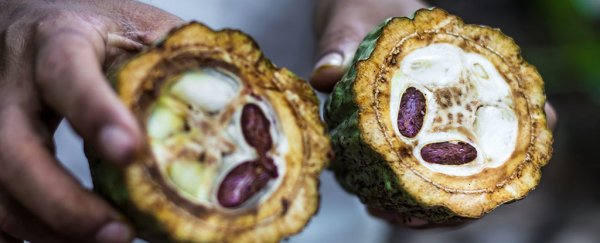Your snacks drawer may have been worth a lot more in the time of the Maya. A new study has revealed chocolate was used as currency by the ancient civilisation, exchanged for goods and services in the same way we might hand over coins or notes.
Dominating Mesoamerica during the first millennium CE, the Maya never used actual coins, but exchanged items like tobacco, maize, and clothing instead. Chocolate was among those accepted forms of payment, this latest study shows.
In fact a shortage of chocolate might have helped bring about the downfall of this legendary dynasty, according to archaeologist Joanne Baron from the Bard Early College Network in New Jersey, who carried out the research.
However, we're not talking about the sort of confectionary bars we have today, but rather the cacao beans used to make chocolate and chocolate drinks.
The Classic Maya period (250-900 CE) saw "the monetisation of cacao beans and woven textiles, which would eventually serve as universal currencies that crossed ethnic and linguistic boundaries" writes Baron.
"By the time of Spanish contact in 1519, these products were used to facilitate buying and selling in marketplaces, to gamble, and as payments for tribute and labour."
Records show arriving Europeans used cacao beans to pay workers in the 16th century, so to find out if the practice was established before then, Baron looked at Maya artwork from the period as well as earlier research.
She found a lot more depictions of chocolate in murals, ceramic paintings, and carvings from the 8th century onwards, suggesting this is when the beans switched from something to be bartered with to a recognised currency that could be traded on its own.
Baron eventually uncovered some 180 scenes dating from 691 CE and later showing cacao beans being offered up as a tribute or tax alongside grain and clothing – and if the tax man is accepting chocolate beans, it's a safe bet that the currency is widely accepted.
As Baron points out, the Maya leaders are shown collecting way more cacao beans than they would actually make into chocolate, emphasising their use as a way of paying people or buying goods at the market.
"What is clear from this art repertoire is that cotton and cacao were frequently used as payment for obligations – usually from subordinates to overlords," writes Baron.
"Furthermore, the collection of cacao beans as tribute, rather than exclusively prepared liquid chocolate, facilitated their use as a store of value for future transactions."
Together with the Aztecs, the Maya are credited with being the first people to make chocolate from cacao beans, first as a frothy drink and then as a delicacy. Back in those days though, it would've tasted very different, being made with chilli peppers and water.
Unlike cotton, cacao beans need pretty specific conditions to grow, adding to their value, and Baron suggests shifts in the climate or natural disasters affecting cacao bean production may well have had an impact on the Maya economy.
Maybe a cacao bean shortage disrupted the ability of ruling parties to levy taxes or to pay their bills, destabilising the political landscape of the Classic Maya period.
That's not a view shared by anthropologist and Maya expert David Freidel, from Washington University in Missouri, who wasn't involved in the study – he says the availability of other currencies like grain and clothing would have helped balance the system out.
"My guess is that one commodity crashing would not cause the system to crash," Freidel told Joshua Rapp Learn from Science.
However, he does agree that cacao beans were used by the Maya in the same way as we might use coins today – so the next time you try and bribe someone with a chocolate bar, remember the practice has been going on for longer than you might think.
The research has been published in Economic Anthropology.
